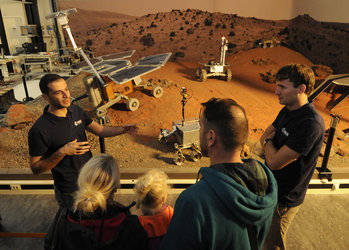Accept all cookies Accept only essential cookies See our Cookie Notice

About ESA
The European Space Agency (ESA) is Europe’s gateway to space. Its mission is to shape the development of Europe’s space capability and ensure that investment in space continues to deliver benefits to the citizens of Europe and the world.
Highlights
ESA - United space in Europe
This is ESA ESA facts Member States & Cooperating States Funding Director General Top management For Member State Delegations European vision European Space Policy ESA & EU Space Councils Responsibility & Sustainability Annual Report Calendar of meetings Corporate newsEstablishments & sites
ESA Headquarters ESA ESTEC ESA ESOC ESA ESRIN ESA EAC ESA ESAC Europe's Spaceport ESA ESEC ESA ECSAT Brussels Office Washington OfficeWorking with ESA
Business with ESA ESA Commercialisation Gateway Law at ESA Careers Cyber resilience at ESA IT at ESA Newsroom Partnerships Merchandising Licence Education Open Space Innovation Platform Integrity and Reporting Administrative Tribunal Health and SafetyMore about ESA
History ESA Historical Archives Exhibitions Publications Art & Culture ESA Merchandise Kids Diversity ESA Brand Centre ESA ChampionsLatest
Space in Member States
Find out more about space activities in our 23 Member States, and understand how ESA works together with their national agencies, institutions and organisations.
Science & Exploration
Exploring our Solar System and unlocking the secrets of the Universe
Go to topicAstronauts
Missions
Juice Euclid Webb Solar Orbiter BepiColombo Gaia ExoMars Cheops Exoplanet missions More missionsActivities
International Space Station Orion service module Gateway Concordia Caves & Pangaea BenefitsLatest
Space Safety
Protecting life and infrastructure on Earth and in orbit
Go to topicAsteroids
Asteroids and Planetary Defence Asteroid danger explained Flyeye telescope: asteroid detection Hera mission: asteroid deflection Near-Earth Object Coordination CentreSpace junk
About space debris Space debris by the numbers Space Environment Report In space refuelling, refurbishing and removingSafety from space
Clean Space ecodesign Zero Debris Technologies Space for Earth Supporting Sustainable DevelopmentLatest
Applications
Using space to benefit citizens and meet future challenges on Earth
Go to topicObserving the Earth
Observing the Earth Future EO Copernicus Meteorology Space for our climate Satellite missionsCommercialisation
ESA Commercialisation Gateway Open Space Innovation Platform Business Incubation ESA Space SolutionsLatest
Enabling & Support
Making space accessible and developing the technologies for the future
Go to topicBuilding missions
Space Engineering and Technology Test centre Laboratories Concurrent Design Facility Preparing for the future Shaping the Future Discovery and Preparation Advanced Concepts TeamSpace transportation
Space Transportation Ariane Vega Space Rider Future space transportation Boost! Europe's Spaceport Launches from Europe's Spaceport from 2012Latest

6: Setting standards for space
Thank you for liking
You have already liked this page, you can only like it once!
When companies manufacture components, systems or entire satellites for space they follow a single technical ‘recipe book’ that ESA helps write and keeps updated.
We are a leading member of a body called the European Cooperation for Space Standardization, an initiative to develop a single set of user-friendly standards for all European space activities, from project management and parts manufacturing to the testing of both hardware and software.
This results in continual improvements in the quality, functional integrity and compatibility of all space projects, while reducing costs. It also helps define whole new markets, by ensuring parts from different companies end up being fully interoperable.
As a practical example of ECSS in effect, the top solderers in Europe receive training in these standards in order to work on ESA missions.
On the international level, ESA represents Europe in the ‘Consultative Committee for Space Data Systems’ with our international partners. Its technical standards enable true cooperation through interoperability for the benefit of national agencies, established space companies and new commercial space actors.
Through this committee for instance, ESA’s Mars Express in orbit around the Red Planet can relay data from NASA’s Curiosity rover on the surface, as can ESA’s Trace Gas Orbiter. Similarly ESA ground stations can be used to communicate with missions of our partners and vice versa.
ESA is also the driving force behind the European Space Components Coordination, a set of processes that among other benefits, produces a ‘European Preferred Parts List’ – a regularly updated list of fully-qualified, high-performance parts for use in space. Its existence boosts mission reliability and makes European companies more competitive in global markets.
Next part: Ground tracking stations
(Photo: Space component microsections for quality checks)
ESA Basic Activities at Space19+
ESA’s next Ministerial Council, Space19+, set for the end of this year, the Agency is asking Europe’s space ministers for a substantial investment for its core Basic Activities, helping to support a new generation of space missions as efficiently as possible. ESA’s Basic Activities have three main objectives: to enable the future through early stage research and development, commencing the Agency’s seamless grid of innovation; develop and maintain ESA’s common infrastructure and expertise; and, develop, preserve and disseminate knowledge for European capacity building and sustainable growth – inspiring and promoting creativity.
-
CREDIT
ESA-Sergi Ferreté Aymerich -
LICENCE
ESA Standard Licence

ESTEC Open Day

Micro-sections of circuit boards

Space Team Europe for Ariane 6: Sergi Inglada

Visitors to ESTEC's Planetary Robotics Lab















 Germany
Germany
 Austria
Austria
 Belgium
Belgium
 Denmark
Denmark
 Spain
Spain
 Estonia
Estonia
 Finland
Finland
 France
France
 Greece
Greece
 Hungary
Hungary
 Ireland
Ireland
 Italy
Italy
 Luxembourg
Luxembourg
 Norway
Norway
 The Netherlands
The Netherlands
 Poland
Poland
 Portugal
Portugal
 Czechia
Czechia
 Romania
Romania
 United Kingdom
United Kingdom
 Slovenia
Slovenia
 Sweden
Sweden
 Switzerland
Switzerland
























